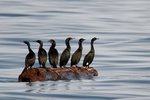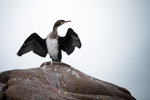

There are huge numbers of Double-crested Cormorants now nesting along the east side of Woodard Bay. The parents are visiting their chicks, now hatched and issuing a steady loud chorus of begging calls as the adults fly in. The adults of the colony bring back fish to feed their young, urping up these fish from their gullet for the young to swallow whole.
This drama takes place in the Woodard Bay Natural Resources Conservation Area, a brief and worthwhile drive north of Olympia.
Growing birds, killing trees
This rookery has been occupied annually for some years now, and repeated nest activity over time has killed some of the nest trees. That’s sad for the trees but great for birdwatchers, because now we can see nests and young clearly. The trees die because of the large amounts of urea and other bird wastes end up smothering the tree roots. It’s not an uncommon phenomenon at densely utilized seabird rookeries.
Cormorants are common to our area year-round. They feed on fish and are never far from water. They’re big birds with wingspans over four feet (larger than a Red-tailed Hawk). Adults are all black except for an orangish hue at their face and bill. These bills are large and thin, with sharp teeth – ideal for diving underwater to catch fish. The “double-crests” refers to breeding plumes that are seldom visible.
Where to find Cormorants
You can see Double-crested Cormorants on or near most of our freshwater lakes and along the marine shoreline. Sometimes in the evening you might notice a few large black birds with crooked necks flying along. These likely are Double-crested Cormorants returning to their evening roost site.
Cormorants have interesting and unusual feathers. In contrast to almost all other water birds, their feathers do not have water-resistant oils. Therefore, as they dive their feathers become waterlogged. Sometimes you can see them swimming with only their heads sticking up. To dry off, cormorants need to perch out of the water with outstretched wings. Many regularly used rocky drying perches become covered with their white droppings. Sometimes you will also see them perched on pilings and docks with outstretched wings.
Three species of Cormorants
We have two other cormorant species in our area, Brant’s Cormorant and Pelagic Cormorant, both nesting in northern Puget Sound and the Washington Coast but wintering along our marine shorelines in the South Sound. They look and behave like the double-crested but are smaller and do not fly with a crooked neck. The Pelagic is much smaller, with a wingspan of about 3 feet. Sometimes you can see a white patch on the adult’s flanks. The Brant’s is sized in-between the other two and, in good light, you might notice that its bill and throat patch are gray and bluish.
Like bird dogs
In Asia, cormorants are captured, tamed and traditionally used for small-scale fishing. They are fitted with a neck ring attached to a long line. Operating from a small boat, the “fisherman” casts the cormorant overboard, hauling it back up when it has caught a fish and forcing the cormorant to give up its catch.
A few words about Woodard Bay
If you haven’t been to the Woodard Bay, you’re missing out. There’s a paved road trail, not quite a mile long, that is wheelchair assessable. It ends at what was a railroad terminus where logs used to be dumped in the bay and then rafted north to lumber mills. It passes by some of the oldest Douglas Fir and Grand Fir trees in the county and has several view points, including one overlooking the cormorant rookery.
From the terminus you might spot Bald Eagles, Purple Martins and other water birds. There are also often Harbor Seals – and, at dusk, the bonus of bats flying out from under the old pier.
There’s also a trail that loops through a wonderful older forest, as well as a wetland. This forest is home to lots of smaller birds. There is a small parking area at the entrance that requires a State Discover Pass (a good investment for future access to state natural areas).
Bird watching at Woodard Bay is good year-round, even in the winter when there can be small rafts of wintering water birds.
George Walter is the environmental program manager at the Nisqually Indian Tribe’s natural resources department; he also has a 40+ year interest in bird watching. He may be reached at george@theJOLTnews.com
4 comments on this item Please log in to comment by clicking here
wildnature
I'm so glad you wrote about Woodard Bay. I have seen the cormorant rookery and was baffled by the dead trees. I never would have guessed they were caused by the birds droppings! I thought some poisonous gas had come through because the ground is scorched and there are bird skeletons laying around on it. Why are the skeletons there? Thanks for the info. I never was able to find anything about it on line about Woodard Bay. And also, is that east side closed during nesting season for the herons? When are those dates?
Friday, July 22, 2022 Report this
Georgewalter
Bones - When a baby bird falls from the rookery nest, it dies. It cannot climb back up and the parents cannot reach it. This happens multiple times each year Also, the young may drop an offered fish. More bones. My understanding is that access to the extreme north end of the Chehalis Western trail is closed during the cormorant nesting season and there is an information sign with the closure dates. I expect nesting is over by the end of August
Sunday, July 24, 2022 Report this
fredfinn
Good Article! Thank you.
Tuesday, July 26, 2022 Report this
JJmama
It's a wonderful area to visit, but I do it so much less these days because of the terribly high amount of car break-ins that goes on in their parking lot. It's the worst place in the entire county that I know of (along with the small Flora Vista lot at the north end of Squaxin Park--Priest Point), and it's been going on for many years. There should be some kind of security hired there for awhile to clean this up, or at least some patrolling by law enforcement.
You often pull in and see multiple piles of window glass lying in 6 or 7 parking spots, victims of break-ins.
It sure is a disincentive for people who want to get out in nature and AVOID urban calamities---not encourage them.
Thursday, August 4, 2022 Report this